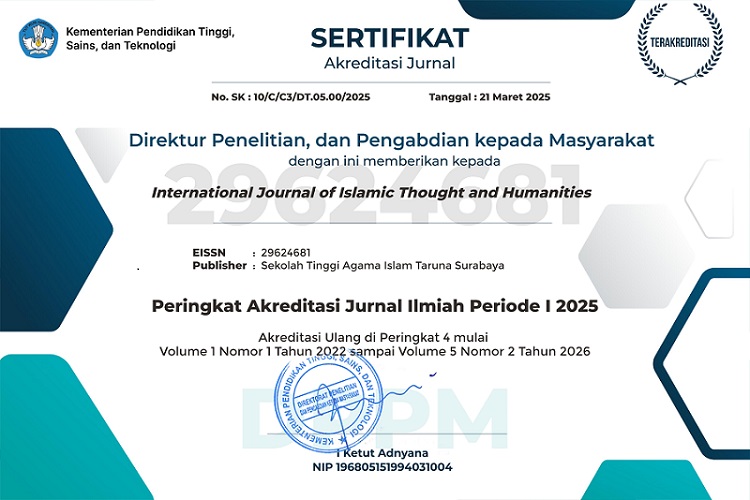Learning Management of Islamic Religious Education (PAI) Based on Multiple Intelligences at SMA IT Insan Mandiri Cibubur
DOI:
https://doi.org/10.54298/ijith.v2i1.52Keywords:
Multiple Intelligences, Islamic Religious EducationAbstract
This research is entitled "Learning Management of Islamic Religious Education (PAI) Based on Multiple Intelligences at SMA IT Insan Mandiri Cibubur". The purpose of this research is to explain how the SMA IT Insan Mandiri Cibubur High School as an education provider institution applies the concept of "Multiple Intelligences" to makes a learning model based on "Multiple Intelligences". The writer deliberately took PAI learning as a sample to make it easier for writer in the research process and not to widen and focus too much. Because in essence this study aims to find out a comprehensive model of the concept of learning based on multiple intelligences. This research is a type of qualitative research with a phenomenological approach. The conclusions of this study stated: That the implementation management of the "Multiple Intelligences" based learning concept that implemented by SMA IT Insan Mandiri Cibubur includes the learning planning process, learning implementation and assessment of learning outcomes. In planning learning, teacher use a database of students' multiple intelligences research (MIR) results, this is to make it easier for teachers to prepare lesson plans (RPP), and than teacher can choose a variety of strategies and learning methods, which are adjusted to the learning style and intelligence tendencies of students. Then in the implementation of learning, the teacher implements what has been prepared in the lesson plan (RPP) by implementstion with attractive learning and fun learning with the aim of sparking the various potentials of the students and using the “quantum teaching method” and implementation of project based qur’an (PBQ). The last process is the assessment of learning outcomes, by using authentic assessment, its named a balanced and objective assessment in each domain, both cognitive, affective and psychomotor.
Downloads
References
Al-Jawi, M. S. (2006). Pendidikan di Indonesia: Masalah dan Solusinya. Makalah Dalam Seminar Nasional Potret Pendidikan Indonesia: Antara Konsep Realiti Dan Solusi, Diselenggarakan Oleh Forum Ukhwah Dan Studi Islam (FUSI) Universitas Negeri Malang, 11.
Astuti, J. (2018). RAHASIA MULTIPLE INTELLIGENCE PADA ANAK. Journal ISTIGHNA, 1(2). https://doi.org/10.33853/istighna.v1i2.3
Bimbingan, B., & Konseling, D. A. N. (2016). Metode Penelitian Kualitatif dalam Bidang Bimbingan dan Konseling. Jurnal Fokus Konseling, 2(2).
Dolati, Z., & Tahriri, A. (2017). EFL Teachers’ Multiple Intelligences and Their Classroom Practice. SAGE Open, 7(3). https://doi.org/10.1177/2158244017722582
Erviana, Y. (2018). Centered Learning Approach Sebagai Media Pengembangan Kecerdasan Jamak Anak Usia Dini (Studi Kasus Di Tk Islam Plus Mutiara Yogyakarta). Vol. 1(2), 120–133.
Fauzi, A. (2017). Integrasi Dan Islamisasi Ilmu Dalam Perspektif Pendidikan Islam. Jurnal Pendidikan Islam, 8(1), 1–18.
Ghaznavi, N., Haddad Narafshan, M., & Tajadini, M. (2021). The Implementation of a Multiple Intelligences Teaching Approach: Classroom engagement and physically disabled learners. Cogent Psychology, 8(1). https://doi.org/10.1080/23311908.2021.1880258
Habibi, Y., Srifariyati, S., Hasan, H., & Subhi, M. R. (2017). Strategi Pembelajaran Anak Usia Dini Berbasis Multiple Intelligence. Madaniyah, 7(2), 237–260. https://journal.stitpemalang.ac.id/index.php/madaniyah/article/view/88
Hasbiansyah, O. (2008). Pendekatan Fenomenologi: Pengantar Praktik Penelitian dalam Ilmu Sosial dan Komunikasi. Mediator: Jurnal Komunikasi, 9(1). https://doi.org/10.29313/mediator.v9i1.1146
Istiningsih, & Nisa, A. F. (2015). Implementasi Multiple Intelligences dalam Pendidikan Dasar. Al-Bidayah: Jurnal Pendidikan Dasar Islam, 7(2).
Kuswarno, E. (2006). Tradisi Fenomenologi pada Penelitian Komunikasi Kualitatif: Sebuah Pengalaman Akademis. Mediator: Jurnal Komunikasi, Http://Journal.Unpad.Ac.Id/Sosiohumaniora/Article/View/5384/2746, 07(1).
McKenzie, W. (2005). Multiple Intelligences and Instructional Technology. In International Society For Tecnology in Education (ISTE).
Michael, M. G., & Trezek, B. J. (2006). Universal design and multiple literacies: Creating access and ownership for students with disabilities. Theory into Practice, 45(4). https://doi.org/10.1207/s15430421tip4504_4
Prameswati, L. N. (2019). Analisis Kemampuan Baca Tulis Al-Qur’an Siswa MTS Dalam Perspektif Taksonomi Bloom. Jurnal Edudeena, 3(2).
Rahman, A. (2018). Desain Model dan Materi Pembelajaran Berbasis Teknologi Informasi. AL-ISHLAH: Jurnal Pendidikan Islam, 16(2), 128–143. https://doi.org/10.35905/alishlah.v16i2.743
Saragih, E. S. (2018). ANALISIS DAN MAKNA TEOLOGI KETUHANAN YANG MAHA ESA DALAM KONTEKS PLURALISME AGAMA DI INDONESIA. Jurnal Teologi Cultivation, 2(1). https://doi.org/10.46965/jtc.v2i1.175
Setyosari, P. (2017). MENCIPTAKAN PEMBELAJARAN YANG EFEKTIF DAN BERKUALITAS. JINOTEP (Jurnal Inovasi Dan Teknologi Pembelajaran) Kajian Dan Riset Dalam Teknologi Pembelajaran. https://doi.org/10.17977/um031v1i12014p020
Su’dadah, S. (1970). KEDUDUKAN DAN TUJUAN PENDIDIKAN AGAMA ISLAM DI SEKOLAH. Jurnal Kependidikan, 2(2). https://doi.org/10.24090/jk.v2i2.557
Subhi, M. R. (2015). Penelitian Agama menurut H.A. Mukti Ali dan Kontribusinya Terhadap Pendidikan Islam. Jurnal Madaniyah Edidsi VIII, XVI(2086–3462).
Sujono, I., Malaka, Z., Istifhama, L., Nasiri, N., & Anah, S. (2022). Efforts to Strengthen Islamic Moderation of Islamic Religious Universities in Indonesia. Proceedings of the 6th Batusangkar International Conference, BIC 2021, 11 - 12 October, 2021, Batusangkar-West Sumatra, Indonesia. https://doi.org/10.4108/eai.11-10-2021.2319459
Supriadi, S. (2015). PERKEMBANGAN FENOMENOLOGI PADA REALITAS SOSIAL MASYARAKAT DALAM PANDANGAN EDMUND HUSSERL. Scriptura, 5(2). https://doi.org/10.9744/scriptura.5.2.52-61
Downloads
Published
How to Cite
Issue
Section
License
Copyright (c) 2023 Agus Syukur, Abuddin Nata, Dede Rosyada, Fadhilah Suralaga

This work is licensed under a Creative Commons Attribution-ShareAlike 4.0 International License.
Authors who publish with this journal agree to the following terms:
- Authors retain copyright and grant the journal right of first publication with the work simultaneously licensed under a Creative Commons Attribution-ShareAlike 4.0 that allows others to share the work with an acknowledgement of the work's authorship and initial publication in this journal.
- Authors are able to enter into separate, additional contractual arrangements for the non-exclusive distribution of the journal's published version of the work (e.g., post it to an institutional repository or publish it in a book), with an acknowledgement of its initial publication in this journal.
- Authors are permitted and encouraged to post their work online (e.g., in institutional repositories or on their website) prior to and during the submission process, as it can lead to productive exchanges, as well as earlier and greater citation of published work (See The Effect of Open Access).


















